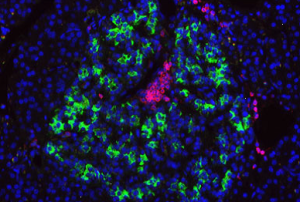Clues to Early T1D Disease Process Found in Donated Tissues
in Prevention, Research
Tissues donated to JDRF program allow better characterization of islet inflammation in T1D – a key understanding towards stopping the type 1 diabetes disease process.
Seven years ago, JDRF launched the JDRF Network for Pancreatic Organ Donors with Diabetes (nPOD) program to collect and characterize pancreata and related tissues from organ donors with type 1 diabetes (T1D), as well as from those who are autoantibody positive but not insulin dependent. These tissues are then made available to investigators addressing the most fundamental questions related to how T1D develops and progresses. The program’s creation grew out of the insight that although animal models for the T1D exist, they differ from the human disease in many key aspects and raised the concern that some data derived from such models may not be applicable to the disease in humans. In fact, even after a century of T1D research we know very little about some of the basics of T1D in people at the cellular level, because of the very limited amount of human tissue that is available for study. nPOD has been helping change that.
This unique resource, made possible thanks to the thoughtful decisions by hundreds of organ and tissue donors and their families, has produced a steady flow of critical insights into the T1D disease process over the years and supported numerous advances on the path to cure and prevent the disease. In yet another advance, a group of researchers recently published a new way to define the presence of insulitis, a key aspect of understanding the human T1D disease process, based on analyzing nPOD samples. Insulitis is the infiltration of destructive immune cells among the groups of insulin-producing beta cells in the pancreas called islets – often at the earliest stages of the disease process. Together with the presence of T1D autoantibodies, insulitis is a critical marker of the beginning of the T1D disease process. Knowing when it occurs and how much is occurring is critical to understanding the disease process and how far it has progressed. Insulitis provides direct evidence that the beta cells within the islets are being destroyed by the immune system. But recognizing the occurrence of insulitis isn’t a simple matter. That’s why a group of researchers met to standardize the definition of insulitis in the T1D disease process using the nPOD resource.
Organized by nPOD, this meeting of leading T1D researchers formed a consensus definition of insulitis in T1D for the first time and published it in a leading diabetes scientific journal. This will now allow other researchers to more consistently characterize the progress of T1D and potentially allow more targeted prevention and intervention therapies to be developed in the future.
To learn more about the JDRF nPOD program and planning an organ donation, please visit: JDRFnPOD.
